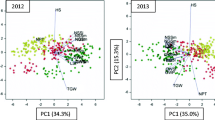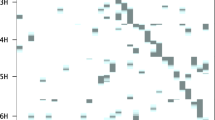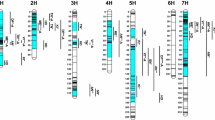Abstract
Advanced backcross (AB)-quantitative trait locus (QTL) analysis has been successfully applied for detecting and transferring QTLs from unadapted germplasm into elite breeding lines in various plant species. Here, we describe the application of a modified AB breeding scheme to spring barley. A BC3-doubled haploid (DH) population consisting of 181 lines derived from the German spring barley cultivar ‘Brenda’ (Hordeum vulgare subsp. vulgare) as the recurrent parent and the wild species line ‘HS213’ (H. vulgare subsp. spontaneum) as the donor line was evaluated for yield and its components as well as malting quality traits. A set of 60 microsatellite markers was used to genotype the population, and phenotypic data were collected at two locations in Germany in continuous years. Altogether, 25 significant QTLs were detected by single-marker regression analysis and interval mapping. Most positive QTLs originated from the recurrent parent ‘Brenda’. A QTL, Qhd2.1, on chromosome 2HS from ‘Brenda’ explained 18.3% and 20.7% of the phenotypic variation for yield and heading date, respectively. Due to the small percentage of donor-parent genome of 6.25%, the BC3-DH lines could be directly used for the extraction of near-isogenic lines (NILs) for Qhd2.1. Consequently, it was possible to determine the precise location of the locus hd2.1 within a region of 6.5 cM, using an F2 population consisting of 234 individuals developed from a cross between an NIL containing a defined donor segment at this locus and ‘Brenda’. The location of this QTL was consistent with the presence of a major photoperiod response gene, Ppd-H1, previously reported in this region, which is associated with pleiotropic effects on yield components. In summary, the analysis of a BC3-DH population in barley provides a compromise between the analysis of QTLs by means of an AB scheme and the generation of defined substitution lines. Several lines carrying defined different donor segments for only one single chromosome or trait in the genetic background of ‘Brenda’ could be selected for further genetic studies.



Similar content being viewed by others
References
Ayoub A, Symons SJ, Edney MJ, Mather DE (2002) QTLs affecting kernel size and shape in a two-rowed by six-rowed barley cross. Theor Appl Genet 105:237–247
Backes G, Graner A, Foroughi-Wehr B, Fischbeck G, Wenzel G, Jahoor A (1995) Localization of quantitative trait loci (QTL) for agronomic important characters by the use of an RFLP map in barley (Hordeum vulgare L.). Theor Appl Genet 90:294–302
Barua UM, Chalmers KJ, Thomas WTB, Hackett CA, Forster BP, Waugh R, Powell W (1993) Molecular mapping of genes determining height, time to heading, and growth habit in barley (Hordeum vulgare). Genome 36:1080–1087
Baum M, Grando S, Backes G, Jahoor A, Sabbagh A, Ceccarelli S (2003) QTLs for agronomic traits in the Mediterranean environment identified in recombinant inbred lines of the cross ‘Arta’× H. spontaneum 41-1. Theor Appl Genet 107:1215–1225
Bernacchi D, Beck Bunn T, Eshed Y, Lopez J, Petiard V, Uhlig J, Zamir D, Tanksley S (1998) Advanced backcross QTL analysis in tomato. I. Identification of QTLs for traits of agronomic importance from Lycopersicon hirsutum. Theor Appl Genet 97:381–397
Bezant J, Laurie D, Pratchett N, Chojecki J, Kearsey MJ (1997) Mapping QTL controlling yield and yield components in a spring barley (Hordeum vulgare L.) cross using marker regression. Mol Breed 3:29–38
Eshed Y, Zamir D (1995) An introgression line population of Lycopersicon pennellii in the cultivated tomato enables the identification and fine mapping of yield-associated QTL. Genetics 141:1147–1162
Frary A, Nesbitt TC, Frary A, Grandillo S, van der Knaap E, Cong B, Liu J, Meller J, Elber R, Alpert KB, Tanksley SD (2000) fw2.2: a quantitative trait locus key to the evolution of tomato fruit size. Science 289:85–88
Fridman E, Pleban T, Zamir D (2000) A recombination hotspot delimits a wild-species quantitative trait locus for tomato sugar content to 484 bp within an invertase gene. Proc Natl Acad Sci USA 97:4718–4723
Fulton TM, Beck-Bunn T, Emmatty D, Eshed Y, Lopez J, Petiard V, Uhlig J, Zamir D, Tanksley SD (1997) QTL analysis of an advanced backcross of Lycopersicon peruvianum to the cultivated tomato and comparisons with QTLs found in other wild species. Theor Appl Genet 95:881–894
Fulton TM, Grandillo S, Beck Bunn T, Fridman E, Frampton A, Lopez J, Petiard V, Uhlig J, Zamir D, Tanksley SD (2000) Advanced backcross QTL analysis of a Lycopersicon esculentum × Lycopersicon parviflorum cross. Theor Appl Genet 100:1025–1042
Huang XQ, Cöster H, Ganal MW, Röder MS (2003) Advanced backcross QTL analysis for the identification of quantitative trait loci alleles from wild relatives of wheat (Triticum aestivum L.). Theor Appl Genet 106:1379–1389
Kicherer S, Backes G, Walther U, Jahoor A (2000) Localising QTLs for leaf rust resistance and agronomic traits in barley (Hordeum vulgare L.). Theor Appl Genet 100:881–888
Kleinhofs A, Kilian A, Maroof MAS, Biyashev RM, Hayes P, Chen FQ, Lapitan N, Fenwick A, Blake TK, Kanazin V, Ananiev E, Dahleen L, Bollinger J, Knapp S, Liu B, Sorrells M, Heun M, Franckowiak JD, Hoffman D, Skadrna R, Steffenson BJ (1993) A molecular, isozyme and morphological map of the barley (Hordeum vulgare) genome. Theor Appl Genet 86:705–712
Lander ES, Green P, Abrahamson J, Barlow A, Daly MJ, Lincoln SE, Newburg L (1987) MAPMAKER: an interactive computer package for constructing primary genetic linkage maps of experimental and natural populations. Genome 1:174–181
Laurie AD, Pratchett N, Bezant JH, Snape JW (1994) Genetics analysis of a photoperiod response gene on the short arm of chromosome 2(2H) of Hordeum vulgare (barley). Heredity 72:619–627
Laurie DA, Pratchett N, Bezant JH, Snape JW (1995) RFLP mapping of five major genes and eight quantitative trait loci controlling flowering time in a winter × spring barley (Hordeum vulgare L.) cross. Genome 38:575–585
Li JZ, Sjakste TG, Röder MS, Ganal MW (2003) Development and genetic mapping of 127 new microsatellite markers in barley. Theor Appl Genet 107:1021–1027
Liu ZW, Biyashev RM, Saghai Maroof MA (1996) Development of simple sequence repeat DNA markers and their integration into a barley linkage map. Theor Appl Genet 93:869–876
Marquez-Cedillo LA, Hayes PM, Jones BL, Kleinhofs A, Legge WG, Rossnagel BG, Sato K, Ullrich SE, Wesenberg DM (2000) QTL analysis of malting quality in barley based on the doubled-haploid progeny of two elite North American varieties representing different germplasm groups. Theor Appl Genet 101:173–184
Marquez-Cedillo LA, Hayes PM, Kleinhofs A, Legge WG, Rossnagel BG, Sato K, Ullrich SE, Wesenberg DM (2001) QTL analysis of agronomic traits in barley based on the doubled-haploid progeny of two elite North American varieties representing different germplasm groups. Theor Appl Genet 103:625–637
Matus I, Corey A, Filichkin T, Hayes PM, Vales MI, Kling J, Riera-Lizarazu O, Sato K, Powell W, Waugh R (2003) Development and characterization of recombinant chromosome substitution lines (RCSLs) using Hordeum vulgare subsp. spontaneum as a source of donor alleles in a Hordeum vulgare subsp. vulgare background. Genome 46:1010–1023
Moncada PP, Martinez CP, Borrero J, Chatel M, Gauch H Jr, Guimaraes E, Tohme J, McCouch SR (2001) Quantitative trait loci for yield and yield components in an Oryza sativa × Oryza rufipogon BC2F2 population evaluated in an upland environment. Theor Appl Genet 102:41–52
Nelson J (1997) Qgene: software for marker-based genomic analysis and breeding. Mol Breed 3:239–245
Paterson AH, Lander ES, Hewitt JD, Peterson S, Lincoln SE, Tanksley SD (1988) Resolution of quantitative traits into Mendelian factors by using a complete linkage map of restriction fragment length polymorphisms. Nature 335:721–726
Pillen K, Zacharias A, Léon J (2003) Advanced backcross QTL analysis in barley (Hordeum vulgare L.). Theor Appl Genet 107:340–352
Pillen K, Zacharias A, Léon J (2004) Comparative AB-QTL analysis in barley using a single exotic donor of Hordeum vulgare ssp. spontaneum. Theor Appl Genet 108:1591–1601
Ramsay L, Macaulay M, Ivanissevich degli S, MacLean K, Cardle L, Fuller J, Edwards KJ, Tuvesson S, Morgante M, Massari A, Maestri E, Marmiroli N, Sjakste T, Ganal M, Powell W, Waugh R (2000) A simple sequence repeat-based linkage map of barley. Genetics 156:1997–2005
Schiex T, Gaspin C (1997) CARTHAGENE: constructing and joining maximum likelihood genetic maps. Mol Biol 5:258–267
Takahashi Y, Shomura A, Sasaki T, Yano M (2001) Hd6, a rice quantitative trait locus involved in photoperiod sensitivity, encodes the α subunit of protein kinase CK2. Proc Natl Acad Sci USA 98:7922–7927
Tanksley SD, McCouch SR (1997) Seed banks and molecular maps: unlocking genetic potential from the wild. Science 277:1063–1066
Tanksley SD, Nelson JC (1996) Advanced backcross QTL analysis: a method for the simultaneous discovery and transfer of valuable QTLs from unadapted germplasm in elite breeding lines. Theor Appl Genet 92:191–203
Tanksley SD, Grandillo S, Fulton TM, Zamir D, Eshed Y, Petiard V, Lopez J, Beck-Bunn T (1996) Advanced backcross QTL analysis in a cross between an elite processing line of tomato and its wild relative L. pimpinellifolium. Theor Appl Genet 92:213–224
Teulat B, Merah O, Sirault X, Borries C, Waugh R, This D (2001) QTLs for agronomic traits from Mediterranean barley progeny grown in several environments. Theor Appl Genet 103:774–787
Thomas WTB, Powell W, Swanston JS (1991) The effects of major genes on quantitatively varying characters in barley. 4. The G pert and denso loci and quality characters. Heredity 66:381–389
Thomas WTB, Powell W, Waugh R, Chalmers KJ, Barua UM, Jack P, Lea V, Forster BP, Swanston JS, Ellis RP, Hanson PR, Lance RCM (1995) Detection of quantitative trait loci for agronomic, yield, grain and disease characters in spring barley (Hordeum vulgare L.). Theor Appl Genet 91:1037–1047
Wehrhahn C, Allard RW (1965) The detection and measurement of the effects of individual genes involved in the inheritance of a quantitative character in wheat. Genetics 51:109–119
Xiao J, Li J, Grandillo S, Ahn S, Yuan L, Tanksley SD, McCouch SR (1998) Identification of trait-improving quantitative trait loci alleles from a wild rice relative, Oryza rufipogon. Genetics 150:899–909
Yamamoto T, Kuboki Y, Lin SY, Sasaki T, Yano M (1998) Fine mapping of quantitative trait loci Hd-1, Hd-2 and Hd-3, controlling heading date of rice, as single Mendelian factors. Theor Appl Genet 97:37–44
Yano M, Katayose Y, Ashikari M, Yamanouchi U, Monna L, Fuse T, Baba T, Yamamoto K, Umehara Y, Nagamura Y, Sasaki T (2000) Hd1, a major photoperiod sensitivity quantitative trait locus in rice, is closely related to the Arabidopsis flowering time gene CONSTANS. Plant Cell 12:2473–2484
Acknowledgements
This research was supported by the grant 2690A/0087L from the state Sachsen-Anhalt. We thank Barbara Apel and Sonja Allner for excellent technical assistance during the field experiments.
Author information
Authors and Affiliations
Corresponding author
Additional information
Communicated by J.W. Snape
Rights and permissions
About this article
Cite this article
Li, J.Z., Huang, X.Q., Heinrichs, F. et al. Analysis of QTLs for yield, yield components, and malting quality in a BC3-DH population of spring barley. Theor Appl Genet 110, 356–363 (2005). https://doi.org/10.1007/s00122-004-1847-x
Received:
Accepted:
Published:
Issue Date:
DOI: https://doi.org/10.1007/s00122-004-1847-x




